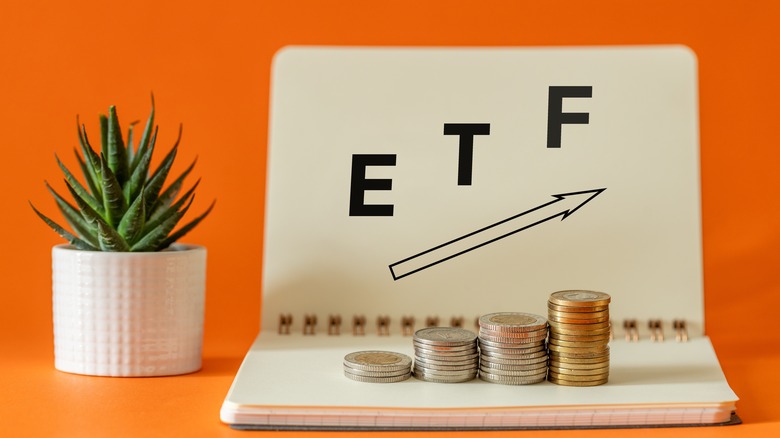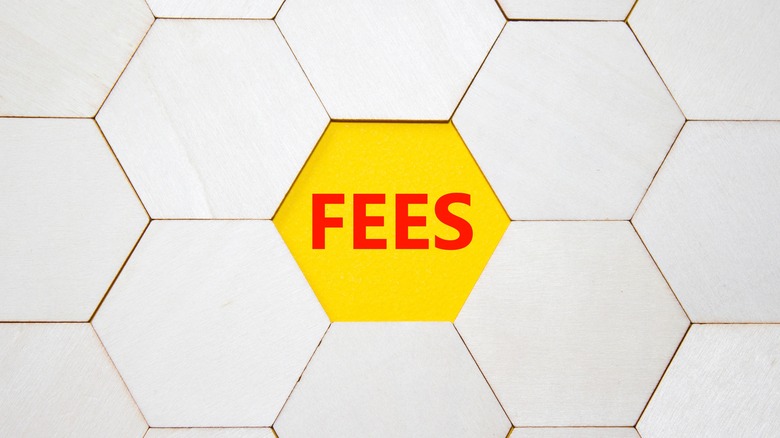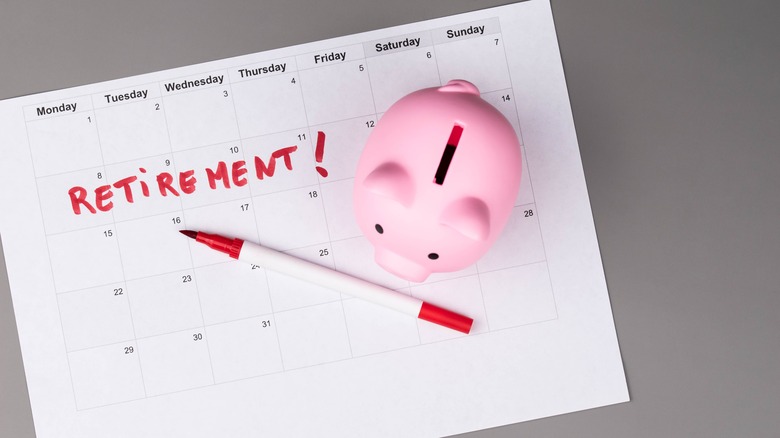Retirees Should Follow These Rules To Reach A $1 Million Retirement Portfolio
Most freely and seriously suggest that they want to retire without enough money to sustain a comfortable and secure final act. Similarly, you'd be hard pressed to find a person who genuinely wants to be forced to continue working for the rest of their days instead of resting and living off of what they have amassed for themselves. With the help of important projects like the Social Security program, retirees have more going for them than just the portfolio they were able to build while working. Even retirees who want to spend their time abroad can take advantage of Social Security benefits.
However, Social Security was never meant to provide a fully funded retirement lifestyle. The program helps lift tens of millions of seniors (and others) out of poverty, providing a framework for those who need support the most and a nice cushion for others. No matter how much you anticipate receiving from Social Security (something you can calculate by setting up an SSA account), growing your own savings portfolio is essential. Many have a $1 million target in mind, or even a figure greater than that major landmark. To retire with the lifestyle you want, this number might not be a nice goal but rather a non-negotiable benchmark. Fortunately, building to that savings goal and then preserving it doesn't have to be difficult or mysterious.
Understand the account types available to you
The first step for any saver hoping to create a sizeable retirement portfolio involves researching account types. Admittedly, this isn't a very exciting part of the process and comes before you have deposited your first dollar toward that envisioned future. It might not seem important to focus on this part of the strategy rather than jumping right into the investment sequence. But those who don't take the time to do this work will absolutely live to regret it later on down the line. The account type you use to protect your retirement assets can either work as a gigantic ally that stands beside you as you continue your retirement planning journey or a massive anchor weighing you down.
Every retirement-specific account you might open features its own unique set of benefits. Most retirees will get a lot of mileage out of the Roth IRA account, though. A Roth IRA allows you to deposit funds into your portfolio that have already been taxed. The result is an upfront relationship that feels a lot like your standard brokerage account. But the fun part kicks in once you pass 59 ½. Taking distributions after this age comes with a monumental benefit that can't be found elsewhere. Rather than having to consider your capital gains tax liabilities, this money is considered yours in its entirety. When taking qualified distributions there is no tax burden, regardless of whether your account has accumulated $1 in additional value or $10 million. Another great option is the 401(k). This tool allows you to utilize employer contribution matches that act as free money put toward your ultimate savings goals.
Start early
The only way to build the portfolio you want is to allow time to play a pivotal role in your money's growth. The longer you leave investments to accumulate value the more valuable your portfolio stands to become. Of course, every year is unique and market conditions can change on a dime. But over the long term investments in the S&P 500 return an annualized growth rate of about 10% since 1957 (not including the effects of inflation). The longer you leave your money in the market the more opportunity it has to continue growing at an exponential rate.
Experts agree that starting early is the absolute best way to reach your savings goals with the least amount of legwork and sacrifice possible. Each additional year you give the market to grow your portfolio ultimately yields a smaller total contribution that will be required directly from your paychecks. To reach $1 million starting at 25, you should expect to invest roughly $360 per month, waiting just one year to begin boosts that contribution requirement to $390; and starting at 30 requires $510 per month. The numbers speak for themselves. By launching your retirement investment portfolio early, you'll make the task of reaching your goals easier while delivering a longer timeline for the market to work its magic.
Invest in ETFs
Yet another strategy that feels underwhelming: Avoiding or minimizing engagement with the stock market in a pure stock picking format is the best option available to investors. Instead, focusing on ETFs and other similar "total market" options will help smooth out the effect of risk over the length of your investment journey. Taking on risk is normal and natural as you make your way through life as an investor. However, there's calculated risk and then there's the leaning into investment decisions that are firmly stacked against your success. Attempting to pick high-performance stocks and then aggressively rebalancing to continue chasing after the highest possible returns is an exercise in insanity. At the outset, it's crucially important to understand that no one is in possession of a crystal ball. Even the most stable brands today can experience immense downward pressure tomorrow. Moreover, approaching the market this way is exhausting; there's a reason why professionals get paid so much to manage large funds and allocate investment resources on a daily basis. This task isn't one that the average investor can succeed at over the long term, and professionals even have a hard time keeping pace with the market's movements.
Instead, an ETF delivers total market exposure while rounding off the rough edges that come from picking individual stocks in both the downturn risk and portfolio rebalancing tasks. ETFs tend to feature algorithmic rebalancing and even actively managed funds will perform these processes for you. Investing in ETFs gives you access to the marketplace as a whole, the exact thing that retirees looking for long term stable growth will want.
Automate or otherwise lock in your contribution schedule
Nothing will throw off growth within your portfolio more than a lapse in action. It's usually not a great idea, but you can borrow against your 401(k) or even take a distribution from a Roth IRA before you age into the qualified distribution window. There are certain rules that govern these actions, but generally speaking you'll take a tax hit by tapping into these funds early. Withdrawing money from these accounts may be required to pay off an emergency bill of some sort or to erase high-interest credit card debt that has been plaguing your savings goals and budgeting needs. But this should be an emergency escape valve of last resort. Subtracting from your account provides two negative pressures on your retirement portfolio.
On the other hand, simply pausing your contributions for a short time will introduce one pressure point. If you're dealing with a sudden financial hardship, this may be unavoidable. However, working as hard as you can to maintain a consistent schedule of deposits is the best way to ensure that you ultimately reach the summit you have set for yourself. The best approach is to set a deposit schedule that you'll be able to maintain over the long term, even if minor inconveniences or financial quirks that change your outlook temporarily make their way into the picture. Life is all about compromise and adaptability, and your retirement strategy needs to reflect this. Automating your deposits is an extra step in the right direction. This makes your deposit schedule run like clockwork and takes the need to actively perform the task out of your hands.
Seek out options with minimal fees
Fees are an investment killer, albeit a silent one lurking in the background. A retiree who has invested in a brokerage account throughout their journey will have to pay taxes on their distributions every time they withdraw funds. This is a direct and obvious cost, and one that can be immensely expensive. This one's hard to ignore and has led investors to seek out tax-advantaged alternatives like the Roth IRA. A different and perhaps much more sinister cost that reduces the value of your portfolio is the fees you pay every month. Some brokerage firms charge fees to clients to use the service in the first place. Others won't charge any fees to open or manage an account, and so paying for this service is absolutely unnecessary in the modern marketplace.
When investing in ETFs you'll typically see a small fee associated with the asset. In this arena for the investment marketplace, that typically comes out to a few dollars per $10,000 invested in the fund. These kinds of expenses aren't generally going to make or break your future, but an investment advisor typically takes a few percentage points off the top of your account on an annual basis. This does amount to a big deal over the long term. A 1% fee translates into $1 paid out to your advisor for every $100 invested annually. Wherever you experience fees, minimizing the expense is critical to keeping your principal intact so that it can grow.
As you near retirement, amplify your savings volume and take advantage of expanded caps
One piece of advice that many investment advisors, financial pundits, and others focus on involves the amount of money you are setting aside for your future. Your IRA accounts feature an annual cap, set at $7,000 for 2025. Your 401(k) offers even greater contribution limits, $23,500 in 2025 with a total limit including employer contributions at $70,000. Ideally, you'll be able to max out these accounts every year, but that's not a sustainable goal for most savers. All kinds of other responsibilities and priorities get in the way, but as you get closer to your retirement date, you'll want to rethink these numbers.
Generally speaking, as you age you experience a gradual uptick in the amount you earn. This increased buying power creates lots of opportunities. For some, this might translate into expanded spending money or the ability to take an extra vacation with their family every year. But each year you step closer to retirement is another year closer to a time when you require the support of your investments. As an even more pressing feature, once you turn 50 you are able to increase the maximum amount allowed for each of your investment accounts. Catch up contributions expand your IRA savings figure by $1,000 in 2025, and your 401(k) offers the ability to invest an additional $7,500. After turning 50, your priorities need to shift and it's likely a good idea to take advantage of these increased thresholds.
Carefully plan your exit from the workforce
You can realistically retire whenever you want. But in the modern world, it's virtually impossible to maintain a comfortable lifestyle without enough income to support yourself. This means that most people will continue working long into their adult years in order to set enough cash aside for this exit. Some investors aggressively pursue early retirement, with adherents to things like the FIRE movement even contemplating ways to enjoy this leisurely lifestyle in their 30s. No matter your exit strategy, it's absolutely critical to think through all of the complexities involved in making that transition from working to support yourself financially to living off your investments. If you retire early, Social Security checks won't feature as a part of your budgetary calculations, for instance. Some investors may have enough set aside that this doesn't deter an early retirement, but others will want to delay in order to receive a larger Social Security check.
Another important thing to keep in mind is that each year you delay your retirement translates into one less year that your investments need to cover. Even if you have enough money set aside to retire at 62 or at full retirement age (67 currently), continuing to work and earn a salary for one or more additional years not only expands the amount you'll receive each month as a benefit check but it gives you additional time to save and more time for your principal to continue growing unencumbered.
Rebalance your portfolio to shift out of riskier assets
Once you enter retirement, growth is no longer your portfolio's primary goal. Maintaining investments in assets that will continue to grow is obviously important, but defending the value of your nest egg becomes the main priority. This means that as you get closer to retirement you'll need to consider strategies to gradually rebalance your portfolio and shift out of riskier investment vehicles. Index funds and other composite investments don't tend to feature as major risk factors, so if your retirement accounts primarily focus on these kinds of tools this strategy becomes slightly less important. Even so, almost no one will have invested solely in things like the Nasdaq-100 or S&P 500 through ETFs and other similar solutions.
Another thing to consider is the use of dividend-producing options. Whether you've focused on these kinds of investments in the past or not, shifting more heavily into dividend producers can be valuable because it allows you to collect earnings from your stock holdings without having to sell the asset itself. Regardless of what your portfolio looks like today, as you cross over into retirement your priorities shift, and so should your investment strategy.
Remember to keep your debt obligations under control throughout both accumulation and drawdown phases
Interest rates on credit cards in particular can severely derail your efforts to save and grow your portfolio. This exists as a major setback both in the accumulation phase and later on. Early on in your savings journey, if you are struggling to pay off credit card balances and other debts it might be worth pausing your contributions for a short time. This, alongside other "austerity" minded personal budgeting strategies, can go a long way to freeing up the cash you need to focus on these costly expenses and get them under control. It's absolutely important to maintain a consistent deposit strategy as you continue to progress toward retirement, but if significant negative pressure is hindering your budget, you won't really have enough room to make a substantial impact.
Moreover, the negative interest rate associated with these debt obligations will ultimately cost you far more than you can hope to make by leveraging your cash for savings rather than an aggressive payoff approach. Dave Ramsey's baby steps can be a valuable support system in this regard. Taking a heavy hand to your debt repayment budgeting elements is Ramsey's second of seven baby steps. He advocates for building a $1,000 emergency fund and then focusing all of your attention on expelling high interest debt from your financial balance. The result might set you back a bit on your way to reaching that $1 million goal, but the alternative is far more damaging.
Stick to a carefully managed drawdown schedule
If you withdraw funds from your account too quickly you will experience the opposite effect of the exponential movement that is crucial to reaching $1 million. The longer you have your money invested the faster it will grow, and the quicker you withdraw that cash the faster it will shrink. This is because a basic element of growth remains a core component in preserving your portfolio. You aren't just putting money in while you work and then taking it back out dollar for dollar once you stop. The math on how to calculate the correct drawdown strategy for your needs is uniquely personal. But it's generally a good idea to consider withdrawing money slower than your account is growing. Naturally, as is the case with many approaches to managing your investment portfolio this is easier said than done.
As mentioned, the S&P 500 delivers a roughly 10% annualized growth rate, which sits at around 6% after taking inflation into account. If you're heavily invested in S&P 500 index funds, drawing down at a rate below this 6% threshold will generally help preserve the value of your assets while still giving you what you need to fund your lifestyle. Put another way, with a $1 million resource pool, 6% translates to $60,000 per year ($5,000 per month) before considering other retirement income sources like your Social Security checks.
But don't forget to have fun in retirement
Lastly, it's important to remember that all of this saving in your earlier years isn't just focused on keeping you alive in retirement. There are all sorts of things that come in old age to rain on your parade. Your budget shouldn't be one of those things that limit what you can do in retirement. That's the entire point of saving to reach a goal like a $1 million portfolio. Adult life is inundated with important and often unsatisfying financial choices. In your earlier years you're likely to sacrifice all kinds of decisions that would enrich your life because of duties to your family, commitments at work, or the pragmatic need to pay for other important action items like a place to live. In retirement many of these financial hurdles melt away.
While plenty of financial pundits advocate for frugal living throughout your life, they also understand that there's plenty of room to kick back and enjoy yourself at times. Mark Cuban suggests spending money on experiences and life improving purchases that can make a big difference in your daily existence. Others like Jim Cramer like to spend their money on tickets for live sporting events and other high impact entertainment experiences. It's important to find the thing that adds value to your own life and focus on it whenever you can. Retirement offers an opportunity to do just that.











